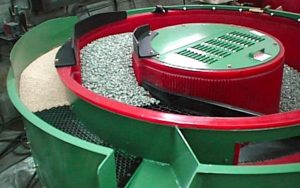 What you need to know about small vibratory finishers
What you need to know about small vibratory finishers
June 13, 2017 REDWIRE is news you can use from leading suppliers. Powered by FRASERS.
Posted by Vibra Finish Limited
Vibra Finish Limited is a manufacturer of vibratory finishing, centrifugal finishing, tumbling, separating, vibro-peenin... Read more
Subscribe
Free REDWIRE e-newsletter

Small vibratory finishers are a top choice for many finishing applications, but there are certain factors to keep in mind to ensure you get the best results and the most out of your investment. As a leading provider of vibratory finishing systems and services, Vibra Finish has this advice:
1. Choose your machine wisely
There are two common types of small vibratory finishers: the small vibratory tub type finisher and the bowl finisher. The tub type is a rectangular tank with a rounded bottom, while the bowl type is shaped like a doughnut. The type chosen should depend on your application’s needs, as well as your budget. For example. the small vibratory tub finisher is more aggressive than the bowl finisher; however, the tubs are usually more expensive.
2. Use the right amount of water
When using small vibratory finishers, water flow must be carefully regulated, as too much water can bring the cutting action to a halt. Machines with a drain in the bowl will allow a constant flow of solution to flush the parts clean, while those without a drain will require a compromise between cutting time and clean parts.
3. Be careful when measuring compounds
When measuring compounds for use in small vibratory finishers, ensure you follow the compound manufacturer’s recommendation for usage. Just a few extra drops of cleaner could cause excessive suds, which will slow down the vibratory action.
4. The load size has to be just right
Small machines will work better if the load is at least three quarters full. Not enough of a load causes poor circulation of the parts and “ding” marks.
5. Small media should never be used on its own
If small media must be used for a job, it should be mixed with large media to help move it around. Small media on its own tends to stick together due to the surface tension of the water. By adding large media to the load, the small media will circulate much better. The best ratio is one part large media to three parts small media.
6. Mildly acidic compounds can help
The cutting action in a small machine can be aided by using a mildly acidic compound when possible. This can lower the surface tension of the solution and reduce the lubricating properties of the water.
For more helpful tips, contact Vibra Finish.
Share
Posted by Vibra Finish Limited
Vibra Finish Limited is a manufacturer of vibratory finishing, centrifugal finishing, tumbling, separating, vibro-peenin... Read more